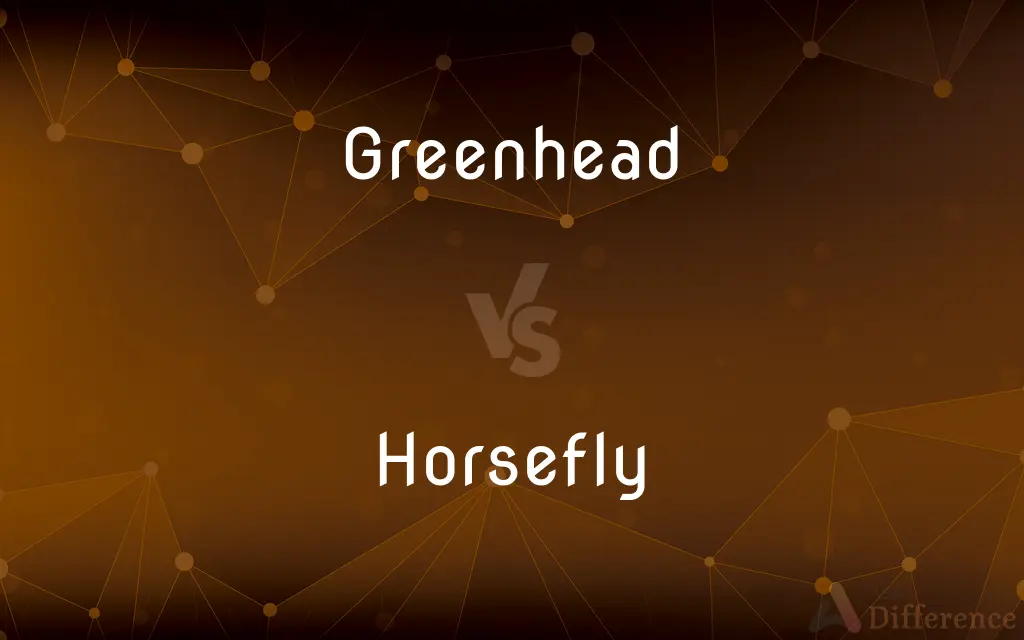Greenhead vs. Horsefly — What's the Difference?
By Tayyaba Rehman & Maham Liaqat — Updated on April 24, 2024
Greenheads, a specific type of horsefly, are notorious for their painful bites, mainly found in marshy coastal areas; horseflies, more broadly, include various species that are pests to livestock.

Difference Between Greenhead and Horsefly
Table of Contents
ADVERTISEMENT
Key Differences
Greenheads are specifically known for their presence in coastal marshes, where they thrive in the warm, humid conditions and are a significant nuisance during the summer months. On the other hand, horseflies are found in a variety of environments, including both rural and wooded areas, and are active throughout the warmer seasons.
The bite of a greenhead is particularly painful because they slice the skin to feed on blood, which can be quite irritating to humans. Whereas horseflies also bite painfully, their impact is more significant in the agricultural sector, where they are a pest to livestock, potentially spreading diseases.
Greenheads are part of the larger horsefly family, Tabanidae, and are especially prevalent in certain geographic areas like the Northeastern United States. In contrast, horseflies are a diverse group with many species distributed globally, affecting not just humans but also animals worldwide.
In terms of control measures, managing greenheads often involves specific strategies such as using traps and reducing breeding grounds in coastal marsh areas. Conversely, controlling horseflies might require broader approaches, including chemical treatments and management of livestock environments to reduce their impact.
Regarding public perception, greenheads are often most discussed in contexts relating to recreational and residential areas near marshes where their presence is acutely felt. Horseflies, however, are generally discussed in the context of agriculture and animal husbandry, reflecting their broader impact on different sectors.
ADVERTISEMENT
Comparison Chart
Habitat
Coastal marshes
Various, including rural and wooded areas
Main Impact
Painful bites on humans
Bites on livestock, potential disease spread
Geographic Prevalence
Particularly in Northeastern US
Global, diverse environments
Control Measures
Traps, reducing breeding grounds
Chemical treatments, livestock management
Common Context of Discussion
Recreational areas near marshes
Agriculture and animal husbandry
Compare with Definitions
Greenhead
A type of horsefly known for inhabiting coastal marsh areas.
During our beach picnic, we were frequently bothered by greenheads.
Horsefly
Belongs to the family Tabanidae and includes various species.
Horseflies are a common problem for both humans and animals during the summer.
Greenhead
Notorious for their painful and persistent biting behavior.
Greenheads can turn a relaxing day at the beach into an uncomfortable ordeal.
Horsefly
Can spread diseases among livestock through their bites.
Horsefly bites can transmit bacterial and viral diseases to cattle.
Greenhead
Active primarily during the day, especially in warm, humid conditions.
Greenheads are most active on calm, sunny days without wind.
Horsefly
Larger than most other flies, making them particularly daunting.
The horsefly's size can be intimidating to people and animals alike.
Greenhead
Females feed on blood, necessary for egg production.
Female greenheads need a blood meal before they can lay eggs.
Horsefly
Pest control involves chemical and physical methods.
Farmers often use insecticidal sprays to protect livestock from horseflies.
Greenhead
Controlled through environmental management and traps.
Many coastal areas use specially designed traps to reduce greenhead populations.
Horsefly
Both males and females feed on nectar, but females also require blood.
Male horseflies are harmless, focusing on nectar, unlike their female counterparts.
Greenhead
A biting horsefly with green eyes.
Horsefly
A stoutly built fly, the female of which is a bloodsucker and inflicts painful bites on horses, humans, and other large mammals.
Greenhead
An ant with a green head and a painful sting.
Horsefly
Any of numerous large biting tabanid flies, the females of which feed on the blood of various mammals.
Greenhead
A male mallard duck.
Horsefly
Any of several medium to large flies, of the family Tabanidae, that suck the blood of mammals (not to be confused with Stomoxys calcitrans, the stable fly, or dog fly).
Greenhead
Any of several horseflies having green eyes, found especially in coastal regions.
Horsefly
Any dipterous fly of the family Tabanidæ, that stings horses, and sucks their blood.
Greenhead
Tabanus nigrovittatus, a biting horsefly.
Horsefly
The horse tick or forest fly (Hippobosca).
Greenhead
The mallard.
Horsefly
Winged fly parasitic on horses
Greenhead
A fish, the striped bass.
Horsefly
Large swift fly the female of which sucks blood of various animals
Greenhead
The mallard.
Greenhead
A state of greenness; verdancy.
Common Curiosities
What environments do greenheads prefer?
Greenheads thrive in coastal marsh areas where conditions are humid.
What is the main impact of horseflies?
They primarily affect livestock, spreading diseases through their bites.
Can horseflies transmit diseases to humans?
While less common, horseflies can potentially transmit diseases to humans as well.
Are horseflies found worldwide?
Yes, horseflies are diverse and can be found in various environments globally.
Why are greenheads particularly problematic during the summer?
They are most active in warm, calm weather, typical of summer conditions.
What role do male horseflies play in the ecosystem?
Male horseflies primarily feed on nectar and help in pollination.
What is a greenhead's biting behavior like?
Greenheads cut the skin to feed on blood, which is painful and can cause swelling.
Do horseflies bite humans as well?
Yes, horseflies can bite humans, often resulting in painful reactions.
How do female horseflies differ from males?
Female horseflies need blood meals to lay eggs, unlike males who only consume nectar.
Are there effective repellents against greenheads?
DEET-based repellents can be somewhat effective, but physical barriers are often necessary.
How can greenheads be controlled?
They can be managed using traps and by reducing potential breeding sites.
What is the life cycle of a greenhead?
Greenheads lay eggs in marshy soil, which hatch into larvae that eventually become adult flies.
What time of day are horseflies most active?
Horseflies are typically most active during daylight hours, especially in sunny conditions.
Are greenheads considered more aggressive than other horseflies?
Yes, greenheads are particularly aggressive when it comes to obtaining blood meals.
How long do horseflies live?
Horseflies generally have a lifespan of a few days to a couple of weeks, depending on environmental conditions.
Share Your Discovery

Previous Comparison
Cocktail vs. Margarita
Next Comparison
Secretion vs. ExcretionAuthor Spotlight
Written by
Tayyaba RehmanTayyaba Rehman is a distinguished writer, currently serving as a primary contributor to askdifference.com. As a researcher in semantics and etymology, Tayyaba's passion for the complexity of languages and their distinctions has found a perfect home on the platform. Tayyaba delves into the intricacies of language, distinguishing between commonly confused words and phrases, thereby providing clarity for readers worldwide.
Co-written by
Maham Liaqat















































